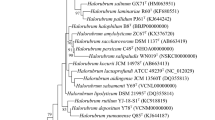Abstract
The relationship between modern pseudomonads andPseudomonas halocrenaea, an organism isolated from Permian salt deposits and claimed to have lived 200 million years ago, was investigated. The following features were studied: DNA base composition; variance of the compositional distribution of the DNA molecules; DNA-hybridization with two pseudomonads and a xanthomonad; pathogenicity; many morphological, physiological, biochemical and enzymic properties. The organism from salt deposits is indistinguishable, both genotypically and phenotypically, fromPseudomonas aeruginosa; it is therefore proposed to include it in the latter species and to discontinue the use of the separate species name “halocrenaea”. The claim that the halocrenaea strain would have lived in a Permian sea is discussed on the basis of molecular-biological, microbiological, chemical and evolutionary data; the evidence makes the above claim extremely unlikely. Unless it is proven beyond refute that these salt deposits have not been recently contaminated e.g. through air or penetration of ground water, “P. halocrenaea” cannot be considered to be a living fossil.
Similar content being viewed by others
References
Abelson, P. H. 1959. Paleobiochemistry and organic geochemistry. Fortschr. Chem. Org. Naturstoffe17 379–403.
Becquerel, P. 1950. La vie latente des graines aux confins du zéro absolu. Compt. Rend.231 1274–1277.
de Beer, G. 1964. Atlas of evolution. Th. Nelson & Sons, London.
Beerstecher, E., Jr., 1954. Petroleum microbiology. Elsevier Press, N.Y.
Bergey's Manual of determinative bacteriology. 1957. Ed. by R. S. Breed, E. G. D. Murray and N. Smith. Williams and Wilkins Co., Baltimore.
Bien, E. undSchwartz, W. 1965. Geomikrobiologische Untersuchungen. VI. Über das Vorkommen konservierter toter und lebender Bakterienzellen in Salzgesteinen. Z. Allgem. Mikrobiol.5 185–205.
Bolton, E. T., Britten, R. J., Byers, T. J., Cowie, D. B., Hoyer, B., Kato, Y., McCarthy, B. J., Mirand, M. andRoberts, R. B. 1964. Annual report of the Director of the Department of Terrestrial Magnetism. Carnegie Inst. Wash. Year Book63 366–397.
Bühlmann, X., Vischer, W. A. andBruhin, H. 1961. Identification of apyocyanogenic strains ofPseudomonas aeruginosa. J. Bacteriol.82 787–788.
Colwell, R. R. 1964. A study of features used in the diagnosis ofPseudomonas aeruginosa. J. Gen. Microbiol.37 181–194.
Colwell, R. R. 1965. Proposal of a neotype ATCC 14216, forPseudomonas aeruginosa (Schroeter 1872) Migula 1900 and request for an opinion. Intern. Bull. Bacteriol. Nomen. Taxon.15 87–95.
De Ley, J. 1960. Comparative carbohydrate metabolism and localization of enzymes inPseudomonas and related micro-organisms. J. Appl. Bacteriol.23 400–441.
De Ley, J. 1964.Pseudomonas and related genera. Ann. Rev. Microbiol.18 17–46.
De Ley, J. andFriedman, S. 1965. Similarity ofXanthomonas andPseudomonas deoxyribonucleic acid. J. Bacteriol.89 1306–1309.
De Ley, J. andPark, I. W. 1966. Molecular biological taxonomy of some free-living nitrogen-fixing bacteria. Antonie van Leeuwenhoek32 6–16.
De Ley, J., Park, I. W., Tijtgat, R. andVan Ermengem, J. 1966. DNA homology and taxonomy ofPseudomonas andXanthomonas. J. Gen. Microbiol.42 43–56.
De Ley, J. andVan Muylem, J. 1963. Some applications of deoxyribonucleic acid base composition in bacterial taxonomy. Antonie van Leeuwenhoek29 344–358.
Dombrowski, H. 1960. Balneologische Untersuchungen der Nauheimer Quellen. II.Pseudomonas halocrenaea (nova species). Zentr. Bakteriol. Parasitenk. I. Abt., Orig.178 83–90.
Dombrowski, H. 1963a. Bacteria from paleozoic salt deposits. Ann. N.Y. Acad. Sci.108 453–460.
Dombrowski, H. 1963b. Organismes vivants du paléozoique. Presse Med.71 1148–1152.
Doty, P., Marmur, J. andSueoka, N. 1959. The heterogeneity in properties and functioning of deoxyribonucleic acids. Brookhaven Symp. Biol.12 1–16.
Elrod, R. P. andBraun, A. C. 1942.Pseudomonas aeruginosa; its role as a plant pathogen. J. Bacteriol.44 633–644.
Farrell, M. A. andTurner, H. G. 1932. Bacteria in anthracite coal. J. Bacteriol.23 155–162.
Florkin, M. 1965. Paléoprotéines. Bull. Acad. Roy. Belg., Classe Sci.51 156–169.
Haynes, W. C. 1951.Pseudomonas aeruginosa — its characterization and identification. J. Gen. Microbiol.5 939–950.
Haynes, W. C. andRhodes, L. J. 1962. Comparative taxonomy of crystallogenic strains ofPseudomonas aeruginosa andPseudomonas chlororaphis. J. Bacteriol.84 1080–1084.
Hugh, R. andLeifson, E. 1964. The proposed neotype strains ofP. aeruginosa (Schroeter 1872) Migula 1900. Intern. Bull. Bacteriol. Nomen. Taxon.14 69–84.
Jessen, O. 1965.Pseudomonas aeruginosa and other green fluorescent pseudomonads. Munksgaard, Copenhagen.
Keilin, D. 1959. The problem of anabiosis or latent life: history and current concept. Proc. Roy. Soc. London, B150 149–192.
Kovacs, N. 1956. Identification ofPseudomonas pyocyanea by the oxidase reaction. Nature178 703.
Kuznetsov, S. I., Ivanov, M. V. andLyalikova, N. N. 1963. Introduction to geological microbiology. McGraw-Hill, New York.
Lipman, C. B. 1931. Living microörganisms in ancient rocks. J. Bacteriol.22 183–198.
Lysenko, O. 1961.Pseudomonas — an attempt at a general classification. J. Gen. Microbiol.25 379–408.
McCarthy, B. J. andBolton, E. T. 1963. An approach to the measurement of genetic relatedness among organisms. Proc. Natl. Acad. Sci. U.S.50 156–162.
McIlwain, H. 1937. The phenazine series. Part V. J. Chem. Soc.1937 1701–1711.
Marmur, J. 1961. A procedure for the isolation of deoxyribonucleic acid from microorganisms. J. Mol. Biol.3 208–218.
Prévost. 1963. Quoted inDombrowski, H. (1963b).
Rhodes, M. E. 1958. The cytology ofPseudomonas spp. as revealed by a silver-plating staining method. J. Gen. Microbiol.18 639–648.
Shewan, J. M. 1963. The differentiation of certain genera of gram negative bacteria frequently encountered in marine environments. p. 499–521.In C. H. Oppenheimer, [ed.], Symposium on marine microbiology. Ch. C. Thomas, Springfield, Ill.
Sneath, P. H. A. 1962. Longevity of micro-organisms. Nature195 643–646.
Sneath, P. H. A. 1964. The limits of life. Discovery25 20–24.
Soc. Am. Bacteriologists. 1957. Manual of microbiological methods. McGraw-Hill, New York.
Tasch, P. 1963. Dead and viable fossil salt bacteria. Univ. Wichita Bull. No. 3:39.
Vallentyne, J. R. 1965. Two aspects of geochemistry of amino acids, p. 105–120.In S. W. Fox, [ed.], The origins of prebiological systems. Acad. Press, New York.
Author information
Authors and Affiliations
Rights and permissions
About this article
Cite this article
De Ley, J., Kersters, K. & Park, I.W. Molecular-biological and taxonomic studies onPseudomonas halocrenaea, a bacterium from Permian salt deposits. Antonie van Leeuwenhoek 32, 315–331 (1966). https://doi.org/10.1007/BF02097474
Received:
Issue Date:
DOI: https://doi.org/10.1007/BF02097474



